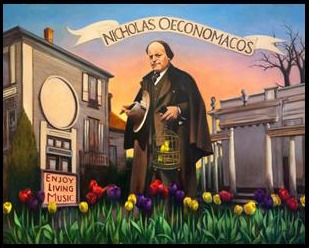Nicholas Oeconomacos was born in 1863 in Sparta, Greece. He learned to make and play finger reed instruments as a boy. Sent to Athens to study music, he arose each day to crouch and practice in a recess on the slopes of the Acropolis.
In the 1890s, when he was over 30, he moved to Paris where he joined the Opera Comique. He then went to New Orleans in 1903, until John Philip Sousa hired him for two world tours which included playing before King Edward VII at Windsor Castle. After a brief residence in California, Oeconomacos came to Seattle in 1906, about the time the first Seattle Symphony performance was being planned.
In 1909, Oeconomacos was listed as a clarinetist with the Seattle Symphony. Before then he provided musical accompaniment to patrons of the Rathskeller, one of Seattle’s early German restaurants. Contemporaries remember his wide-brimmed hat, Dracula-like cape, spats, cane, and jeweled cufflinks.
In 1909, a Post-Intelligencer editorial called his performances “the drowsy meadow melted in liquid tones, the landscape vocalized.” Nineteen years later, the Seattle Times observed: “His performance in a Mozart clarinet quintet . . . was the supreme artistry of Nicholas Oeconomacos that made the Mozart offering outstanding.”
But perhaps Oeconomacos the artist is best conveyed in his own words. Reports The P-I in 1928: “When I go to bed, I take my clarinet and certain of my music with me, so that if inspiration comes at night, or when I wake in the morning, I can up and play under the spell of the moment.”
Meanwhile, Oeconomacos lived in relative poverty. He first settled near Seattle’s Green Lake, a kind of Walden Pond in the early 1900s. Trees, wild birds, and lonely dirt tracks surrounded this first home.
In 1930, the Seattle Symphony entered a period of turmoil, which eventually led to Oeconomacos’ dismissal. A fund drive was launched that year to save the orchestra. At the same time, conductor Karl Krueger introduced “Young People’s Concerts,” where Oeconomacos became a strong draw for audiences.
The next season, with the symphony still fighting for its life, Krueger was replaced by British conductor Basil Cameron. The change coincided with the beginning of radio broadcasts and the end of the old clarinetist’s affiliation with the orchestra. Cameron, meanwhile, quickly earned a reputation as an “exacting orchestra drill master,” and as a “martinet.” In 1931 Oeconomacos found his contract had not been renewed.
Oeconomacos was cited for nonpayment of his electric bill at his Boren Avenue residence. In desperation, he took a seat on an old opera stool in front of the County-City Building and played his instrument. He was later invited to play in the courtroom of Justice of the Peace Charles E. Claypool, and at one point a taxi was placed at his disposal so he could continue playing on a tour of downtown.
Oeconomacos may have foreseen the end of his career with the Seattle Symphony. In 1930, he organized his own group, using key players from the Symphony. In February 1931, the new ensemble performed in the old Seattle Plymouth Church.
Teaching, especially the tutoring of young artists, became a passion. Experts recall that Oeconomacos taught his students to perch on the edge of their chairs and rock back and forth. He was proud of his musical gift and wanted to share it with others. Still later, he hand-built elaborate but rustic studio facilities in his modest homes. By the 1940s, he was taking the bus to Bothell to hold classes in the Bothell High School music room. As each student left, he or she placed a half-dollar on the piano — Oeconomacos’ only income in those lean years.
Despite street performances, solo engagements, and teaching, he lost his Boren home. The old clarinetist then moved to his last residence, a frame building with two addresses: 1175 Roy Street and 625 Minor Avenue North, a corner since obliterated by the Mercer Street Interchange to I-5.
His last house was dubbed “The incredible house of the Terrestrial Globe and of the five continents.” One entered its “Garden of Golden Memories” through the “Gates of Heavenly Music, the Little Flower, and the Lonely Heart.” Photographs and musical knick-knacks were interspersed with hand-crafted objects, an ornate interior stairway, and old carpeting. The backyard boasted an imitation of the Parthenon and the fence around it consisted, in part, of old bedsteads.
Nicholas Oeconomacos died on February 13, age 82. In the requiem mass held in his honor at St. Demetrios, friends and relatives paid tribute to his genius, referring often to what became his signature over the years: Debussy’s “The Little Shepherd” from “The Children’s Corner.”
The year after his death the “House of Terrestrial Globe” was ransacked by vandals. Despite efforts by the police to seal the premises, and appeals from neighbors and a niece in California, the looting continued. One evening a burglar plugged the doorbell, sending into the night air a last note from the old clarinetist’s repertoire.
(A revised version appeared in 1982 as a story written by the author for a column called “Eminent Seattleites” in the Seattle Weekly.)
Discover more from Post Alley
Subscribe to get the latest posts sent to your email.

Mr. Junius
Was this the clarinetist who played the beginning solo of Rhapsody in Blue here when George himself was the pianist?
Thanks kind sir
A.S.
Aside from the dispiriting ending this is just a magic story. Thank you so much for “the drowsy meadow melted in liquid tones, the landscape vocalized.” As a frustrated musician I will take that as inspiration for my artwork, which aspires to translating the mood of music into visual form..
Seattle was often the last horizon for some of our nation’s brilliant, but tortured, souls. I love this story.